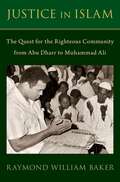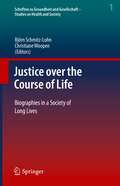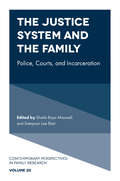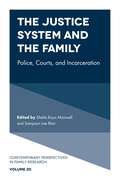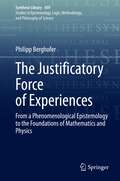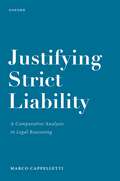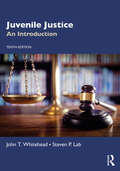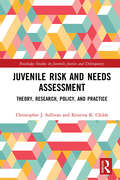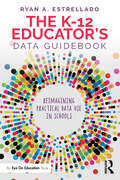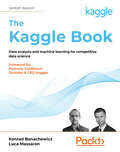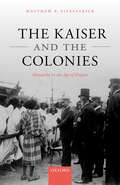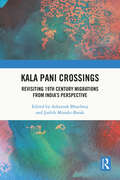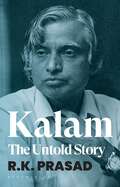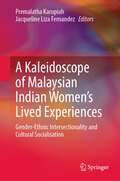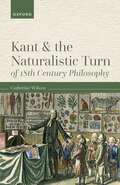- Table View
- List View
Justice in Islam: The Quest for the Righteous Community From Abu Dharr to Muhammad Ali
by Raymond William BakerIslam is the fastest growing of the world's major religions. Yet the pervasive hostility to Islam in the West makes understanding its expanding global reach virtually impossible. Islam is all too often seen through a lens that focuses on the small minority of violent extremists rather than the overwhelming majority of Muslims who make up to the moderate mainstream. It is the centrist mind and heart of Islam that captures new adherents in such impressive numbers. For centuries, Abu Dharr al Ghifari, the seventh-century companion of the Prophet Muhammad, has provided a human face for Islamic justice as the core value of the faith. The influence of Abu Dharr has sometimes faded. Extremism may challenge the moderate and tolerant heart of the Islam of the Qur'an that Abu Dharr represents. Invariably, however, Islamic intellectuals have stepped forward to restore balance and moderation. Our time is such a period of renewal and the sweeping awakening of midstream Islam. In this study of justice in Islam, Raymond Baker focuses on the work of major intellectuals who have contributed to this Islamic Awakening. They include: the Egyptians Hassan al Banna, Sayyid Qutb, and Shaikh Muhammad al Ghazalli; the Turkish scholar Sa'id Nursi; the Lebanese Grand Ayatollah Muhammad Fadlallah; the Iraqi Grand Ayatollah Baqir al Sadra; the Iranian radical intellectual Ali Sheriati; and the American athlete and Muslim convert Muhammad Ali. Baker argues that appreciation for the work of these preeminent figures is indispensable to understanding how an awakened Islam with justice at its core has become a global phenomenon.
Justice over the Course of Life: Biographies in a Society of Long Lives (Schriften zu Gesundheit und Gesellschaft - Studies on Health and Society #1)
by Christiane Woopen Björn Schmitz-LuhnIn this interdisciplinary book, experts from philosophy, medicine, law, psychology, economics, and social sciences address questions and develop solutions for a well-designed society of long life. Young as well as old people have to actively shape more and more of their life span. At the same time, aging becomes more multifaceted: the individual view on one’s own life course is changing, and the needs and demands for a fulfilled life are diversifying. The implications affect all spheres of life – from education and workplace to health care and the culture of interaction. They require content-related and structural adjustments for a diverse society of longevity in which multiple generations live alongside each other. But how can change be managed responsibly, how can individual and collective responsibility be distributed appropriately, and how can a sustainable and fair social future be ensured?
The Justice System and the Family: Police, Courts, and Incarceration (Contemporary Perspectives in Family Research #20)
by Sheila Royo Maxwell, Sampson Lee BlairAround the globe, millions of individuals are entangled in justice systems daily. For individual offenders, contact often begins with the police, frequently leading to court involvement, and for offenders found guilty, to correctional supervision or incarceration. But how do these encounters affect the family? How do police and justice entanglements result in tremendous strains upon families economically and socially? Do they endanger family relationships? To better comprehend how involvement at any level of the justice system affects families, this multidisciplinary edited collection focuses on the justice system and the family. Chapters include topics such as how court processes impact family members and their support networks; how prolonged incarceration impacts children and parenting processes and family coping; how intimate relationships are impacted during and after incarceration including marriage, divorce and partner violence; and, whether system involvement leads to unintended consequences among family members such as heightened fear of crime and victimizations and fears of the police. An enlightening insight into the family dynamics surrounding contact with the justice system, Police, Courts, and Incarceration is interesting reading for researchers and students of family, sociology and criminology.
The Justice System and the Family: Police, Courts, and Incarceration (Contemporary Perspectives in Family Research #20)
by Sheila Royo Maxwell Sampson Lee BlairAround the globe, millions of individuals are entangled in justice systems daily. For individual offenders, contact often begins with the police, frequently leading to court involvement, and for offenders found guilty, to correctional supervision or incarceration. But how do these encounters affect the family? How do police and justice entanglements result in tremendous strains upon families economically and socially? Do they endanger family relationships? To better comprehend how involvement at any level of the justice system affects families, this multidisciplinary edited collection focuses on the justice system and the family. Chapters include topics such as how court processes impact family members and their support networks; how prolonged incarceration impacts children and parenting processes and family coping; how intimate relationships are impacted during and after incarceration including marriage, divorce and partner violence; and, whether system involvement leads to unintended consequences among family members such as heightened fear of crime and victimizations and fears of the police. An enlightening insight into the family dynamics surrounding contact with the justice system, Police, Courts, and Incarceration is interesting reading for researchers and students of family, sociology and criminology.
The Justificatory Force of Experiences: From a Phenomenological Epistemology to the Foundations of Mathematics and Physics (Synthese Library #459)
by Philipp BerghoferThis book offers a phenomenological conception of experiential justification that seeks to clarify why certain experiences are a source of immediate justification and what role experiences play in gaining (scientific) knowledge. Based on the author's account of experiential justification, this book exemplifies how a phenomenological experience-first epistemology can epistemically ground the individual sciences. More precisely, it delivers a comprehensive picture of how we get from epistemology to the foundations of mathematics and physics.The book is unique as it utilizes methods and insights from the phenomenological tradition in order to make progress in current analytic epistemology. It serves as a starting point for re-evaluating the relevance of Husserlian phenomenology to current analytic epistemology and making an important step towards paving the way for future mutually beneficial discussions. This is achieved by exemplifying how current debates can benefit from ideas, insights, and methods we find in the phenomenological tradition.
Justifying Strict Liability: A Comparative Analysis in Legal Reasoning
by Marco CappellettiThe imposition of strict liability in tort law is controversial, and its theoretical foundations are the object of vigorous debate. Why do or should we impose strict liability on employers for the torts committed by their employees, or on a person for the harm caused by their children, animals, activities, or things? In responding to this type of questions, legal actors rely on a wide variety of justifications. Justifying Strict Liability explores, in a comparative perspective, the most significant arguments that are put forward to justify the imposition of strict liability in four legal systems, two common law, England and the United States, and two civil law, France and Italy. These justifications include: risk, accident avoidance, the 'deep pockets' argument, loss-spreading, victim protection, reduction in administrative costs, and individual responsibility. By looking at how these arguments are used across the four legal systems, this book considers a variety of patterns which characterise the reasoning on strict liability. The book also assesses the justificatory weight of the arguments, showing that these can assume varying significance in the four jurisdictions and that such variations reflect different views as to the values and goals which inspire strict liability and tort law more generally. Overall, the book seeks to improve our understanding of strict liability, to shed light on the justifications for its imposition, and to enhance our understanding of the different tort cultures featuring in the four legal systems studied.
Justitiabler Klimaschutz in Deutschland: Welchen Beitrag können Gerichte zum Klimaschutz leisten? (Schriftenreihe des Instituts für Klimaschutz, Energie und Mobilität)
by Michael KalisIn dieser Schrift wird aufbauend auf den Erkenntnissen der Climate Change Litigation und dem Phänomen der sog. Klimaklagen die Justitiabilität von Klimaschutz in Deutschland untersucht. Dabei wird der Untersuchungsgegenstand auf Klimaschutzklagen, d.h. auf vertikale Klagen von Privaten gegen den Staat mit dem Begehren auf verbesserte oder sonst adäquate Klimaschutzmaßnahmen, beschränkt. Nach einer Auseinandersetzung mit dem meist diffusen Begriff der Justitiabilität wird eine eigenständige Definition mit anschließendem Prüfungskanon entwickelt, der danach fragt, ob und inwieweit Klimaschutz vor deutschen Gerichten einklagbar ist; aber auch fragt, ob und inwieweit einschlägige Streitigkeiten zur gerichtlichen Klärung geeignet sind. Im Rahmen der Prüfung von Einklagbarkeit und Eignung werden die wesentlichen Herausforderungen der Klimaklagen identifiziert und – unter Berücksichtigung einschlägigen internationalen und europäischen Rechts – nach prozessualen und materiellen Verfassungsrecht geprüft. Unter Begründung eines subjektiven Rechts auf Klimaschutz im Sinne eines Schutzes der Freiheitsvoraussetzungen sowie unter Anwendung einer Abwägungsfehlerlehre als gerichtlicher Kontrollmaßstab wird die Justitiabilität von Klimaschutz in Deutschland bejaht. Dabei erfolgt – im deutschsprachigen Raum erstmals – eine monografische Auseinandersetzung mit dem sog. Klima-Beschluss des Bundesverfassungsgerichts.
The Jute Genome (Compendium of Plant Genomes)
by Chittaranjan Kole Liwu Zhang Haseena KhanThis book is the first comprehensive compilation of deliberations on jute botanical descriptions, germplasm resources, genetic diversity and population structure, DUS test and DNA fingerprinting, interspecific hybridization, classical genetics, cytology and cytogenetics, genetic transformation; and detailed enumeration on molecular mapping, genome sequencing initiatives of three major jute fiber producing countries, interspecific and intergeneric comparative genomics, organellar genomes, elucidation on functional genomics and genomics resources and database. Genetics and genomics of bast fiber development, biotic stress resistance, abiotic stress tolerance, and flowering pathways have also been discussed. It also presents a narrative on the power of molecular markers and genomics technology on jute breeding. Altogether, the book contains about 400 pages over 21 chapters authored by internationally reputed experts on the relevant field in this crop. This book will be useful to the students, teachers and scientists in the academia and relevant private companies interested in agronomy, genetics, pathology, entomology, physiology, molecular genetics and breeding, genetic engineering, and structural and functional genomics.
Juvenile Justice: An Introduction
by John T. Whitehead Steven P. LabJuvenile Justice: An Introduction, Tenth Edition, presents a comprehensive picture of juvenile offending, delinquency theories, and the ways juvenile justice actors and agencies react to delinquency. Whitehead and Lab offer evidence-based suggestions for successful interventions and treatment and examine the prospects for rebalancing the model of juvenile court. This new edition includes insightful analysis and the latest available statistics on juvenile crime and victimization, drug use, court processing, and corrections. Special attention is given to female involvement, disproportionate minority contact, and diversity issues. The text also includes extensive discussion of police shootings, the issue of race, probation reform, life sentences for juveniles, recent Supreme Court decisions, and reform suggestions from Currie and Feld. An essential text for undergraduate juvenile justice courses, this book offers rich pedagogical features and online resources. Each chapter enhances student understanding with Key Terms, a What You Need to Know section, and Discussion Questions. Links at key points in the text show students where to get the latest information.
Juvenile Justice: An Introduction
by John T. Whitehead Steven P. LabJuvenile Justice: An Introduction, Tenth Edition, presents a comprehensive picture of juvenile offending, delinquency theories, and the ways juvenile justice actors and agencies react to delinquency. Whitehead and Lab offer evidence-based suggestions for successful interventions and treatment and examine the prospects for rebalancing the model of juvenile court. This new edition includes insightful analysis and the latest available statistics on juvenile crime and victimization, drug use, court processing, and corrections. Special attention is given to female involvement, disproportionate minority contact, and diversity issues. The text also includes extensive discussion of police shootings, the issue of race, probation reform, life sentences for juveniles, recent Supreme Court decisions, and reform suggestions from Currie and Feld. An essential text for undergraduate juvenile justice courses, this book offers rich pedagogical features and online resources. Each chapter enhances student understanding with Key Terms, a What You Need to Know section, and Discussion Questions. Links at key points in the text show students where to get the latest information.
Juvenile Risk and Needs Assessment: Theory, Research, Policy, and Practice (Routledge Studies in Juvenile Justice and Delinquency)
by Christopher J. Sullivan Kristina K. ChildsThis book takes a comprehensive, analytic approach to understanding Juvenile Risk and Needs Assessment (JRNA), covering elements relevant to how the practice affects youths’ cases and the juvenile justice system. The work draws on both analysis of the extensive research on risk and needs assessment in the juvenile justice system as well as data from the authors’ recent work in the area. Authors Sullivan and Childs have extensive experience in teaching about and doing research on the juvenile justice system, including multiple studies on juvenile risk and needs assessment tools and their implementation. This expansive, integrative book leaves readers with a realistic sense of "where things stand" on the theory, research, policy, and practice of JRNA. By bringing together existing ideas and assessing them in depth, it identifies possible future paths and sparks ideas for improving the juvenile justice response to delinquent and at-risk youths. Juvenile Risk and Needs Assessment is essential reading for scholars of juvenile justice system impact and reform as well as practitioners engaged in youth and juvenile justice work ranging from the preventive to the rehabilitative stages.
Juvenile Risk and Needs Assessment: Theory, Research, Policy, and Practice (Routledge Studies in Juvenile Justice and Delinquency)
by Christopher J. Sullivan Kristina K. ChildsThis book takes a comprehensive, analytic approach to understanding Juvenile Risk and Needs Assessment (JRNA), covering elements relevant to how the practice affects youths’ cases and the juvenile justice system. The work draws on both analysis of the extensive research on risk and needs assessment in the juvenile justice system as well as data from the authors’ recent work in the area. Authors Sullivan and Childs have extensive experience in teaching about and doing research on the juvenile justice system, including multiple studies on juvenile risk and needs assessment tools and their implementation. This expansive, integrative book leaves readers with a realistic sense of "where things stand" on the theory, research, policy, and practice of JRNA. By bringing together existing ideas and assessing them in depth, it identifies possible future paths and sparks ideas for improving the juvenile justice response to delinquent and at-risk youths. Juvenile Risk and Needs Assessment is essential reading for scholars of juvenile justice system impact and reform as well as practitioners engaged in youth and juvenile justice work ranging from the preventive to the rehabilitative stages.
The K-12 Educator’s Data Guidebook: Reimagining Practical Data Use in Schools
by Ryan A. EstrelladoThe K-12 Educator’s Data Guidebook is a comprehensive field guide for school professionals learning to use data. “Non-data people,” rejoice! Requiring no prior proficiency in data tools and programming, this book validates the implicit challenges of learning to use data to empower educators and features original real-world examples from in-service educators to illustrate common problem-solving. Each chapter uses stories, humor, and a human approach to set the tone for a safe and fun learning experience. Through this highly practical foundation, everyday educators can better engage school initiatives, professional development, and instructional challenges that require competent data use for improving school systems.
The K-12 Educator’s Data Guidebook: Reimagining Practical Data Use in Schools
by Ryan A. EstrelladoThe K-12 Educator’s Data Guidebook is a comprehensive field guide for school professionals learning to use data. “Non-data people,” rejoice! Requiring no prior proficiency in data tools and programming, this book validates the implicit challenges of learning to use data to empower educators and features original real-world examples from in-service educators to illustrate common problem-solving. Each chapter uses stories, humor, and a human approach to set the tone for a safe and fun learning experience. Through this highly practical foundation, everyday educators can better engage school initiatives, professional development, and instructional challenges that require competent data use for improving school systems.
The Kaggle Book: Data analysis and machine learning for competitive data science
by Luca Massaron Konrad Banachewicz Anthony GoldbloomGet a step ahead of your competitors with insights from over 30 Kaggle Masters and Grandmasters. Discover tips, tricks, and best practices for competing effectively on Kaggle and becoming a better data scientist.Key FeaturesLearn how Kaggle works and how to make the most of competitions from over 30 expert KagglersSharpen your modeling skills with ensembling, feature engineering, adversarial validation and AutoMLA concise collection of smart data handling techniques for modeling and parameter tuningBook DescriptionMillions of data enthusiasts from around the world compete on Kaggle, the most famous data science competition platform of them all. Participating in Kaggle competitions is a surefire way to improve your data analysis skills, network with an amazing community of data scientists, and gain valuable experience to help grow your career.The first book of its kind, The Kaggle Book assembles in one place the techniques and skills you'll need for success in competitions, data science projects, and beyond. Two Kaggle Grandmasters walk you through modeling strategies you won't easily find elsewhere, and the knowledge they've accumulated along the way. As well as Kaggle-specific tips, you'll learn more general techniques for approaching tasks based on image, tabular, textual data, and reinforcement learning. You'll design better validation schemes and work more comfortably with different evaluation metrics.Whether you want to climb the ranks of Kaggle, build some more data science skills, or improve the accuracy of your existing models, this book is for you.What you will learnGet acquainted with Kaggle as a competition platformMake the most of Kaggle Notebooks, Datasets, and Discussion forumsCreate a portfolio of projects and ideas to get further in your careerDesign k-fold and probabilistic validation schemesGet to grips with common and never-before-seen evaluation metricsUnderstand binary and multi-class classification and object detectionApproach NLP and time series tasks more effectivelyHandle simulation and optimization competitions on KaggleWho this book is forThis book is suitable for anyone new to Kaggle, veteran users, and anyone in between. Data analysts/scientists who are trying to do better in Kaggle competitions and secure jobs with tech giants will find this book useful.A basic understanding of machine learning concepts will help you make the most of this book.
The Kaiser and the Colonies: Monarchy in the Age of Empire
by Matthew P. FitzpatrickMany have viewed Kaiser Wilhelm II as having personally ruled Germany, dominating its politics, and choreographing its ambitious leap to global power. But how accurate is this picture? As The Kaiser and the Colonies shows, Wilhelm II was a constitutional monarch like many other crowned heads of Europe. Rather than an expression of Wilhelm II's personal rule, Germany's global empire and its Weltpolitik had their origins in the political and economic changes undergone by the nation as German commerce and industry strained to globalise alongside other European nations. More central to Germany's imperial processes than an emperor who reigned but did not rule were the numerous monarchs around the world with whom the German Empire came into contact. In Africa, Asia, and the Pacific, kings, sultans and other paramount leaders both resisted and accommodated Germany's ambitions as they charted their own course through the era of European imperialism. The result was often violent suppression, but also complex diplomatic negotiation, attempts at manipulation, and even mutual cooperation. In vivid detail drawn from archival holdings, The Kaiser and the Colonies examines the surprisingly muted role played by Wilhelm II in the German Empire and contrasts it to the lively, varied, and innovative responses to German imperialism from monarchs around the world.
The Kaiser, Hitler and the Jewish Department Store: The Reich's Retailer
by John F. MuellerFrom the emergence of department stores in the late 19th century to the financial disasters of the years following the end of World War I, the history of large-scale retailing in Germany was dominated by a pioneering generation of German-Jewish entrepreneurs who found fortune and influence only to have their livelihoods taken by Hitler and the Nazis in the 1930s.Drawing on a range of archival sources and private collections, The Kaiser, Hitler and the Jewish Department Store reveals how, contrary to Nazi claims, Jewish-owned department stores were decent employers, popular with customers, and well integrated into the economy. In fact, such institutions were so integral to German society that, when Hitler came to power in 1933, the Nazis were forced to abandon their pledge to abolish them. As this revelatory history argues, the end of the Jewish-run store cannot solely be attributed to the rise of antisemitism: it was also the consequence of financial mismanagement and the indifference of the German people.John F. Mueller reveals the German-Jewish department store as a powerful force in society and politics as well as a leader in architecture and design. His book challenges common assumptions about the relationship between consumer culture, the German-Jewish business community and the rise of Nazism, providing fresh insights into the social history of modern Germany.
Kala Pani Crossings: Revisiting 19th Century Migrations from India’s Perspective
by Ashutosh Bhardwaj Judith Misrahi-BarakWhen used in India, the term Kala pani refers to the cellular jail in Port Blair, where the British colonisers sent a select category of freedom fighters. In the diaspora it refers to the transoceanic migration of indentured labour from India to plantation colonies across the globe from the mid-19th century onwards. This volume discusses the legacies of indenture in the Caribbean, Reunion, Mauritius, and Fiji, and how they still imbue our present. More importantly, it draws attention to India and raises new questions: doesn’t one need, at some stage, to wonder why this forgotten chapter of Indian history needs to be retrieved? How is it that this history is better known outside India than in India itself? What are the advantages of shining a torch onto a history that was made invisible? Why have the tribulations of the old diaspora been swept under the carpet at a time when the successes of the new diaspora have been foregrounded? What do we stand to gain from resurrecting these histories in the early 21st century and from shifting our perspectives? A key volume on Indian diaspora, modern history, indentured labour, and the legacy of indentureship, this co-edited collection of essays examines these questions largely through the frame of important works of literature and cinema, folk songs, and oral tales, making it an artistic enquiry of the past and of the present. It will be of great interest to scholars and researchers of world history, especially labour history, literature, postcolonial studies, cultural studies, diaspora studies, sociology and social anthropology, Indian Ocean studies, and South Asian studies.
Kala Pani Crossings: Revisiting 19th Century Migrations from India’s Perspective
by Ashutosh Bhardwaj Judith Misrahi-BarakWhen used in India, the term Kala pani refers to the cellular jail in Port Blair, where the British colonisers sent a select category of freedom fighters. In the diaspora it refers to the transoceanic migration of indentured labour from India to plantation colonies across the globe from the mid-19th century onwards. This volume discusses the legacies of indenture in the Caribbean, Reunion, Mauritius, and Fiji, and how they still imbue our present. More importantly, it draws attention to India and raises new questions: doesn’t one need, at some stage, to wonder why this forgotten chapter of Indian history needs to be retrieved? How is it that this history is better known outside India than in India itself? What are the advantages of shining a torch onto a history that was made invisible? Why have the tribulations of the old diaspora been swept under the carpet at a time when the successes of the new diaspora have been foregrounded? What do we stand to gain from resurrecting these histories in the early 21st century and from shifting our perspectives? A key volume on Indian diaspora, modern history, indentured labour, and the legacy of indentureship, this co-edited collection of essays examines these questions largely through the frame of important works of literature and cinema, folk songs, and oral tales, making it an artistic enquiry of the past and of the present. It will be of great interest to scholars and researchers of world history, especially labour history, literature, postcolonial studies, cultural studies, diaspora studies, sociology and social anthropology, Indian Ocean studies, and South Asian studies.
Kalam: The Untold Story
by R K PrasadRole model. Icon. Space scientist. Missile man. Bestselling author of books that have sold in millions and been translated into every Indian language. Bharat Ratna. Besides Padma Bhushan and Padma Vibhushan. A following of millions. Dozens of other honours. The most popular President ever.In the small, exclusive world of New Delhi's power centres, however, all that can count for little with the bureaucrats who set the rules and the politicians to whom they report. In Kalam: The Untold Story, R K Prasad, his private secretary from 1995 to his death in 2015, shows us another Kalam-accomplished, successful, always modest despite the high positions he occupied, as also vulnerable and innocent. It is a journey he was part of, from Kalam's time as Scientific Adviser to the Defence Minister and DRDO chief, through Principal Scientific Adviser and President, and the years after the presidency. It throws new light on his relationship with political leaders, including those at the highest level, and the truth behind some of the controversies. Most of all it shows Kalam at his best, facing adversity and disappointment in a way that explains why he was what he was-an extraordinary man.
A Kaleidoscope of Malaysian Indian Women’s Lived Experiences: Gender‐Ethnic Intersectionality and Cultural Socialisation
by Premalatha Karupiah Jacqueline Liza FernandezThis book presents a compilation of chapters relating to the socio-cultural experiences of Malaysian Indian women. It includes a historical background covering Indian women’s migration to Malaya, and explores the lived realities of contemporary Indian women who are members of this minority ethnic group in the country. The authors cover a wide range of issues such as gender inequality, poverty, the involvement of women in performing arts, work, inter‐personal relationships, and well-being and happiness, drawing on substantial empirical data through a gendered lens. This book addresses the gap in the intersectional gender studies literature on minority groups of women in Malaysia, while simultaneously highlighting the multiple forms of subordination minority women - particularly Indian women - experience in society, including those that arise from gender‐ethnic intersectionality. In examining the case of Indian women in Malaysia, it also speaks to and enriches existing literature on the lives of minority groups of women in the Global South more broadly This anthology is beneficial to researchers and students in the social sciences, particularly in disciplines related to gender studies and minority studies. In addition, it is also useful for policy makers and social activists working with minority women in the Global South.
Kalibrierung Der Wissenschaft: Auswirkungen Der Digitalisierung Auf Die Wissenschaftliche Erkenntnis (Science Studies)
by Nicola Mößner Klaus ErlachThe Kamikaze Campaign 1944–45: Imperial Japan's last throw of the dice (Air Campaign)
by Mark LardasAn illustrated history of how Japan devised and launched a new kind of air campaign in late 1944 – the suicidal assaults of the kamikaze units against the approaching Allied fleets.As summer changed to autumn in 1944, Japan was losing the war. Still unwilling to surrender, Japan's last hope was to try to wear down US resolve enough to reach a negotiated settlement. Extraordinary measures seemed necessary, and the most extraordinary was the formation of Special Attack Units – known to the Allies as the kamikazes. The concept of organized suicide squadrons was first raised on June 15, 1944. By August, formations were being trained. These formations were first used in the October 1944 US invasion of the Philippine Islands, where they offered some tactical success. The program was expanded into a major campaign over the rest of the Pacific War, seeing a crescendo during the struggle for Okinawa in April through May 1945. This highly illustrated history examines not just the horrific missions themselves, but the decisions behind the kamikaze campaign, how it developed, and how it became a key part of Japanese strategy. Although the attacks started on an almost ad hoc basis, the kamikaze soon became a major Japanese policy. By the end of the war, Japan was manufacturing aircraft specifically for kamikaze missions, including a rocket-powered manned missile. A plan for a massive use of kamikazes to defend the Japanese Home Islands from invasion was developed, but never executed because of Japan's surrender in August 1945. Packed with diagrams, maps and 3D reconstructions of the attacks, this book also assesses the Allied mitigation techniques and strategies and the reasons and the degree to which they were successful.
Kanonische Experimente der Physik: Fachliche Grundlagen und historischer Kontext
by Peter HeeringDieses Buch ermöglicht in 14 Fallstudien ein tieferes Verständnis von kanonischen Experimenten der Physik und bietet Hintergründe zu deren Aufbauten und Durchführung sowie dem jeweiligen historischen Kontext. Es diskutiert, wie genau diese Experimente ausgeführt wurden und welche physikalischen Gründe es für die Auswahl der verwendeten Instrumente gab. Ebenso wird dargestellt, warum die jeweiligen Forscher diese Experimente durchführten und wie diese Ergebnisse akzeptiert werden konnten.Während eine Reihe von diesen Experimenten und deren Methoden, wie das Geiger-Müller-Zählrohr oder das Youngsche Doppelspaltexperiment, Physiklehrkräften sowie (angehenden) Physikerinnen und Physikern zwar vom Funktionsprinzip her bekannt sind, liefert dieses Buch die Hintergründe um die Herausforderungen zu verstehen, die sich beim Experimentieren stellen und die auch den Reiz des experimentellen Arbeitens ausmachen können. Es verdeutlicht, warum Forschende forschen, worin die Motivation besteht und wie veränderlich naturwissenschaftliche Praktiken in der Zeit sind. Damit leisten die hier zusammengeführten Fallstudien einen Beitrag, Physik nicht als einen Wissenskanon, sondern als einen kulturell geprägten von Menschen getragenen Prozess zu verstehen. Das Buch eignet sich damit besonders für Studierende (sowohl fachwissenschaftlich als auch des Lehramts) sowie Lehrende an Universitäten und (Hoch-)Schulen.Der InhaltDas Hookesche Gesetz – Newtons prismatische Farbzerlegung – Das Coulombsche Gesetz – Youngs Doppelspaltexperiment – Das Ohmsche Gesetz – Die Messung der Lichtgeschwindigkeit durch Fizeau bzw. Foucault – Joules Bestimmung des mechanischen Wärmeäquivalents – Spektralanalyse nach Bunsen und Kirchhoff – Die Wilsonsche Nebelkammer – Das Franck-Hertz-Experiment – Millikans Bestimmung der Elementarladung – Das Geiger-Müller-Zählrohr – Kosmische Hintergrundstrahlung
Kant and the Naturalistic Turn of 18th Century Philosophy
by Catherine WilsonKant's philosophy is usually treated according to 'internalist' textual methodology rather than contextually according to 'externalist' methodology. Kant and the Naturalistic Turn of 18th Century Philosophy presents transcendental idealism, the metaphysics of morals, and other Kantian innovations in philosophy as a reaction to 18th century developments in the life and human sciences. It interprets Kant's metaphysics as motivated by, on one hand, anxiety over the moral dangers he perceived in the empiricism of Buffon, Hume, Smith, and certain German materialists; and, on the other, his theological scepticism. Topics treated include cosmology and the fate of the earth, the mechanical philosophy and the problems of life, mind, and matter, historical pessimism, warfare and class consciousness, and the role of women in 18th century society. This book sheds new light on all major aspects of Kant's philosophy and opens avenues for further research.
